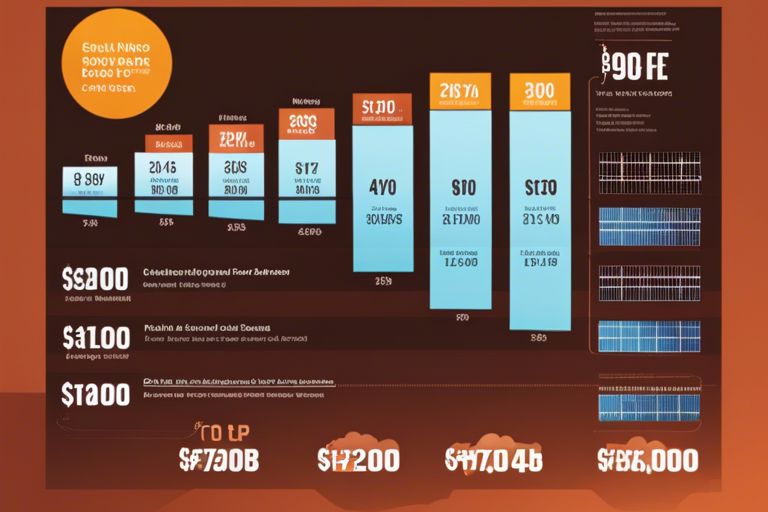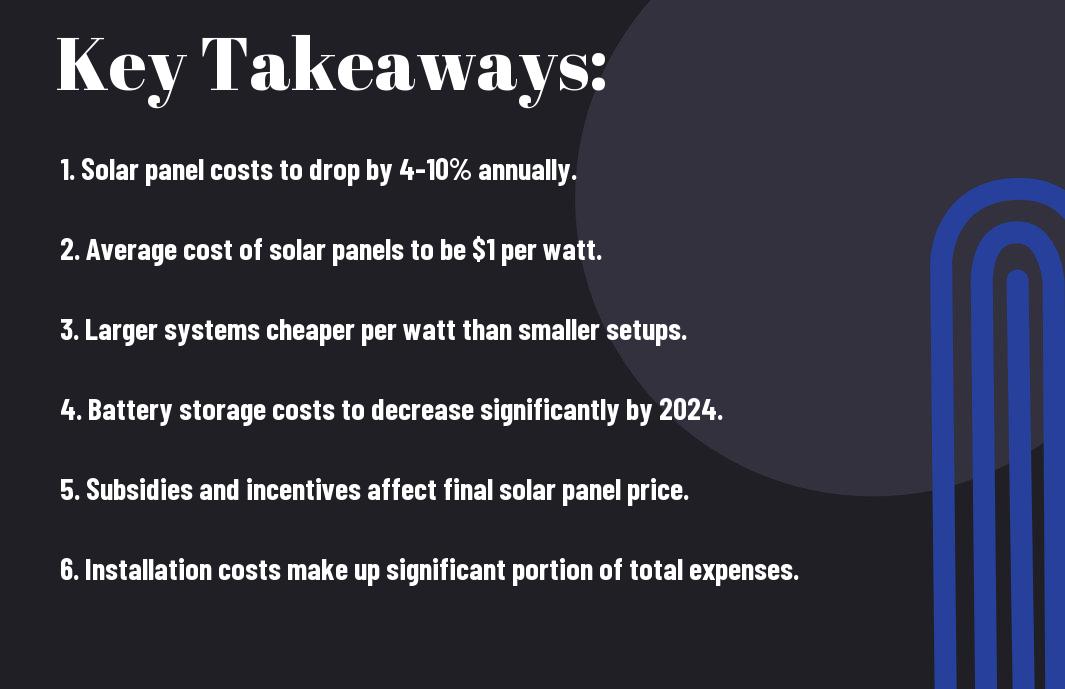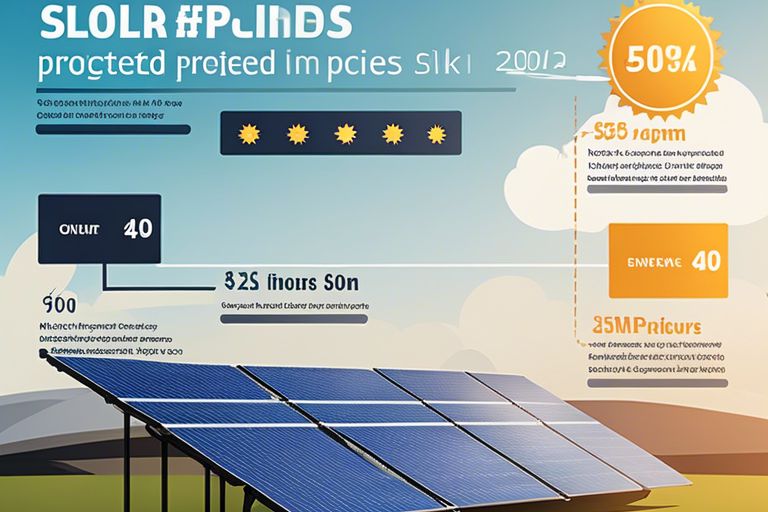Just imagine the possibilities of powering your home with solar energy in 2024. Have you been considering investing in solar panels to reduce your carbon footprint and save on electricity bills? Find out more about the projected cost of solar panels in 2024 in this How Much Do Solar Panels Cost In 2024? informative blog post.

Key Takeaways:
- Continued Price Decline: The cost of solar panels is expected to continue decreasing in 2024.
- Government Incentives: Incentives and tax credits provided by governments can significantly reduce the cost of installing solar panels.
- Technological Advancements: Improvement in solar panel technology may lead to more efficient and cost-effective options.
- Competition Driving Prices Down: Increased competition among solar panel manufacturers can drive prices down further.
- Installation Costs: Installation costs, including labor and equipment, will also impact the overall cost of solar panels in 2024.


The Current State of Solar Panels
A crucial factor in determining the future cost of solar panels is understanding the current state of the market. Solar panels have seen a significant decrease in cost over the past few decades due to technological advancements, economies of scale, and increasing competition among manufacturers.
Historical Price Trends
On examining historical price trends, you will find that the cost of solar panels has dropped by more than 70% in the last ten years. This reduction in price has made solar energy more accessible and appealing to a wider range of consumers, contributing to the rapid growth of the solar industry.
Factors Affecting Cost
One of the main factors affecting the cost of solar panels is the price of raw materials such as silicon, which is the key component in most solar cells. Other factors include manufacturing efficiency, government incentives, and market demand. After analyzing these factors, you can make a more informed decision when considering investing in solar panels.
- Government incentives and subsidies for solar energy installations
- Advancements in technology leading to higher efficiency and lower production costs
This detailed understanding of the factors influencing the cost of solar panels is crucial for predicting how much they will cost in the future. By staying informed and aware of market trends, you can take advantage of the most cost-effective opportunities when considering solar energy for your home or business.
Technological Advancements
Efficiency Improvements
Any significant technological advancements in the solar panel industry will lead to improvements in efficiency. This means that the solar panels of 2024 will be able to convert more sunlight into electricity than ever before. These improvements will not only make solar panels more effective at generating power but also more cost-effective in the long run.
New Materials and Manufacturing Processes
Technological developments in new materials and manufacturing processes will play a crucial role in reducing the cost of solar panels in 2024. By using innovative materials that are cheaper and more readily available, manufacturers will be able to produce solar panels at a lower cost. Additionally, advancements in manufacturing processes, such as automation and streamlined production techniques, will further drive down the overall cost of solar panels.
Manufacturing solar panels with more sustainable materials and eco-friendly processes will not only benefit the environment but also contribute to reducing the overall cost of solar panels. By incorporating recyclable materials and energy-efficient manufacturing practices, solar panel manufacturers can decrease production costs and make solar energy more affordable for consumers.
Economies of Scale
Despite the initial cost of solar panels, their price has been decreasing steadily due to economies of scale. As more and more solar panels are produced and installed, the cost per unit decreases. This means that the more solar panels are manufactured and purchased, the cheaper they become.
Large-Scale Installations
To take advantage of economies of scale, large-scale solar panel installations are becoming more common. With these installations, the cost per watt is significantly lower compared to smaller residential installations. By opting for a large-scale solar panel system, you can benefit from lower costs and a more efficient energy solution for your property.
Government Incentives and Subsidies
For individuals looking to invest in solar panels, government incentives and subsidies can significantly reduce the overall cost of installation. Many governments offer tax credits, rebates, and other financial incentives to encourage the adoption of solar energy. By taking advantage of these programs, you can lower your initial investment and enjoy long-term savings on your energy bills.
Installations in regions with generous incentives can see a quicker return on investment, making solar panels an even more attractive option for homeowners and businesses alike. Be sure to research the incentives available in your area to maximize the financial benefits of going solar.
Regional Variations
Once again, it’s vital to consider regional variations when estimating the cost of solar panels in 2024. Costs can vary significantly from country to country due to factors such as government incentives, regulations, and the availability of sunlight in different regions.
Costs by Country
With solar energy becoming increasingly popular worldwide, the cost of solar panels in each country will depend on various factors. For instance, countries with strong government support and high levels of sunlight, such as Australia, may see lower costs compared to countries with less favorable conditions. In 2024, you can expect to see a range of prices based on the local market conditions and policies in each country.
Local Regulations and Incentives
Country-specific regulations and incentives play a significant role in the cost of solar panels. For example, some countries offer tax credits or rebates for installing solar panels, which can significantly lower the initial investment. On the other hand, certain regulations may make it more expensive to purchase and install solar panels. It’s vital to research the local laws and incentives in your country to get an accurate estimate of how much solar panels will cost you in 2024.
Another crucial factor to consider is the availability of local incentives and rebates that can further reduce the cost of solar panels. By taking advantage of these opportunities, you can make solar energy more affordable and accessible for your home or business.
Installation and Maintenance Costs
Labor and Overhead Expenses
Installation costs for solar panels include labor and overhead expenses. Labor costs can vary based on factors such as the size of the solar panel system, the complexity of the installation, and the location of your property. Overhead expenses cover items like permitting, inspection fees, and general contractor overhead.
Your solar panel installation cost in 2024 will depend on these factors, so it’s vital to get quotes from multiple installers to find the best price that fits your budget.
Ongoing Maintenance and Repair
Installation is not the end of the road when it comes to solar panels. Ongoing maintenance and repair costs are also factors to consider. Routine maintenance can include cleaning the panels, checking the inverter, and ensuring all components are functioning correctly. In the event of a malfunction or damage, repair costs may apply.
It’s important to factor in ongoing maintenance and repair costs when budgeting for solar panels. While solar panels typically require minimal maintenance, it’s crucial to be prepared for any unexpected issues that may arise.
The Impact of Energy Storage
Battery Costs and Integration
Not only have solar panel costs been decreasing, but advancements in energy storage technology have also made significant progress. An important factor to consider in the overall cost of solar panels is the integration of batteries for storing excess electricity generated during peak sunlight hours. As battery technology continues to improve and costs decrease, the ability to store solar energy for later use becomes more accessible and cost-effective.
Grid Parity and Energy Independence
Energy storage plays a crucial role in achieving grid parity and energy independence. By storing excess solar energy in batteries, you can reduce your reliance on the grid during times when solar panels may not be generating electricity, such as at night or on cloudy days. This shift towards energy independence not only provides you with more control over your energy usage but also reduces your overall energy costs in the long run.
The increasing affordability of energy storage solutions means that grid parity, where the cost of solar energy is equal to or cheaper than grid power, is becoming a reality for many homeowners. The ability to store excess energy generated by solar panels allows you to power your home with clean energy around the clock, leading to reduced reliance on traditional energy sources.
Final Words
Following this exploration of the factors that influence the cost of solar panels, you can rest assured that the future looks promising for solar technology. With advancements in manufacturing, increased demand, and supportive policies, the cost of solar panels is expected to continue its downward trend. By 2024, you can anticipate even more affordable options for harnessing the power of the sun.
FAQ
Q: What factors determine the cost of solar panels in 2024?
A: The cost of solar panels in 2024 will be influenced by factors such as the type and quality of panels, installation costs, government incentives, and market demand.
Q: Will the price of solar panels continue to decrease in 2024?
A: It is expected that the price of solar panels will continue to decrease in 2024 due to technological advancements, increased production efficiency, and growing competition in the solar industry.
Q: How can I estimate the cost of installing solar panels for my home in 2024?
A: To estimate the cost of installing solar panels for your home in 2024, you can get quotes from reputable solar companies, consider available incentives and financing options, and calculate the return on investment based on your energy usage and location.
